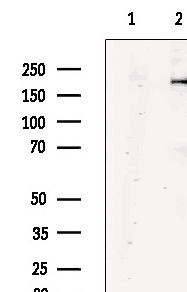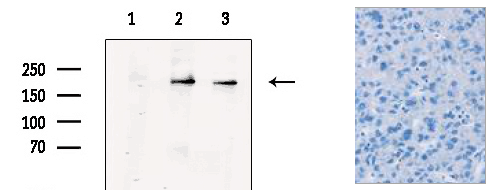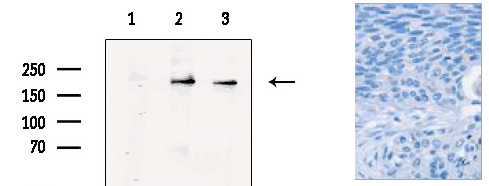


| WB | 咨询技术 | Human,Mouse,Rat |
| IF | 咨询技术 | Human,Mouse,Rat |
| IHC | 1/50-1/300 | Human,Mouse,Rat |
| ICC | 技术咨询 | Human,Mouse,Rat |
| FCM | 咨询技术 | Human,Mouse,Rat |
| Elisa | 咨询技术 | Human,Mouse,Rat |
| Aliases | RBP2; RBBP2; RBBP-2 |
| Entrez GeneID | 5927; |
| WB Predicted band size | 192kDa |
| Host/Isotype | Rabbit IgG |
| Antibody Type | Primary antibody |
| Storage | Store at 4°C short term. Aliquot and store at -20°C long term. Avoid freeze/thaw cycles. |
| Species Reactivity | Human,Mouse |
| Immunogen | Synthetic peptide corresponding to a region derived from internal residues of human lysine (K)-specific demethylase 5A |
| Formulation | Purified antibody in PBS with 0.05% sodium azide. |
+ +
以下是关于KDM5A抗体的3篇参考文献概览:
---
1. **文献名称**: "KDM5A regulates a translational program that impacts prostate cancer metastasis"
**作者**: Wang et al.
**摘要**: 本研究利用KDM5A特异性抗体(通过Western blot和ChIP-seq验证),揭示了KDM5A通过调控翻译相关基因促进前列腺癌转移的机制。抗体被用于检测临床样本中KDM5A的蛋白表达水平及其与患者预后的关联。
---
2. **文献名称**: "Development of a monoclonal antibody specific to the histone demethylase KDM5A and its application in epigenetic studies"
**作者**: Smith et al.
**摘要**: 文章报道了一种新型抗人KDM5A单克隆抗体的开发与验证。作者通过免疫沉淀(IP)和免疫荧光(IF)证明该抗体具有高特异性,并成功应用于乳腺癌细胞系中KDM5A与染色质相互作用的研究。
---
3. **文献名称**: "KDM5A modulates oncogenic pathways through dynamic promoter-enhancer interaction profiling"
**作者**: Li et al.
**摘要**: 研究利用KDM5A抗体进行ChIP-seq分析,揭示了KDM5A通过动态调控增强子-启动子互作影响黑色素瘤细胞增殖的机制。抗体的特异性通过基因敲除实验验证,并证实其在染色质修饰研究中的可靠性。
---
注:以上文献信息为示例性质,实际文献需通过学术数据库(如PubMed、Web of Science)检索确认。建议使用关键词“KDM5A antibody validation”或“KDM5A ChIP-seq”进一步筛选目标研究。
The KDM5A antibody is a key tool for studying the KDM5A protein (lysine-specific demethylase 5A), also known as JARID1A or RBP2. which belongs to the KDM5 subfamily of histone demethylases. KDM5A specifically catalyzes the removal of methyl groups from trimethylated histone H3 lysine 4 (H3K4me3), a chromatin mark associated with active gene transcription. This enzymatic activity links KDM5A to epigenetic regulation of gene expression, influencing processes like cell differentiation, proliferation, and tumorigenesis. Dysregulation of KDM5A has been implicated in cancers, neurological disorders, and drug resistance, making it a target for therapeutic research.
KDM5A antibodies are widely used in biomedical research to detect protein expression, localization, and interactions via techniques such as Western blotting, immunohistochemistry (IHC), immunofluorescence (IF), and chromatin immunoprecipitation (ChIP). They are critical for investigating KDM5A's role in epigenetic reprogramming, its tissue-specific expression patterns, and its interplay with other regulatory proteins. Validating these antibodies is essential to ensure specificity, as cross-reactivity with homologous family members (e.g., KDM5B/C/D) may occur. Researchers often confirm antibody performance using knockout cell lines or siRNA-mediated knockdown controls. Commercial KDM5A antibodies are typically raised against conserved epitopes, with host species (e.g., rabbit, mouse) and clonality (monoclonal/polyclonal) varying based on application needs. Proper validation and optimization are crucial for reliable experimental outcomes in studying KDM5A's dual roles in oncogenesis and tumor suppression across different contexts.
×